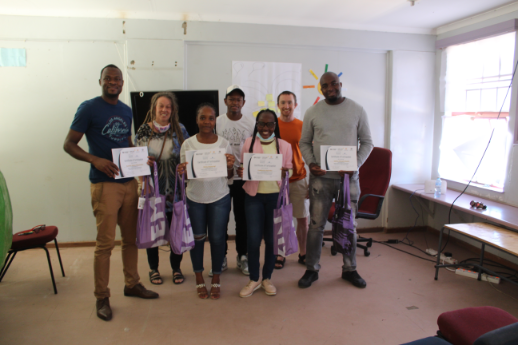“Connecting two universes”
Live Streaming for Education: Learners and Teachers at Peoples Primary School (PPS), interact with 3D live streaming holograms
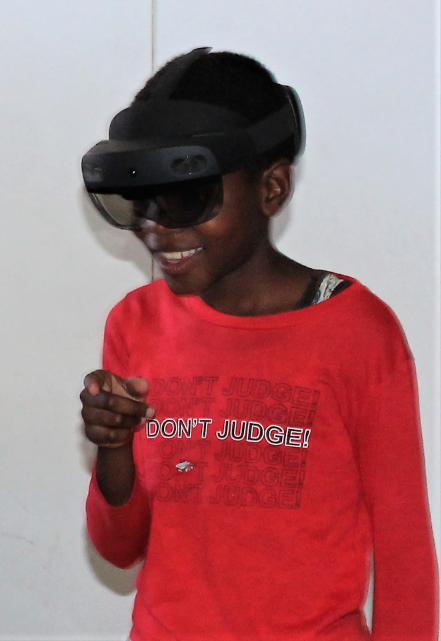 A one-week workshop from April 04th -08th, took place at Peoples Primary school, Windhoek, Namibia. The event was hosted to allow the learners and teachers participating in it, to explore the new 3D live streaming technology utilizing the Microsoft HoloLens and Lidar Technology as well as to share educational practices of engagement and design novel interactions to guide future developments of the technology to be used in an educational context. Mr. Patrick Xoagub PPS principal welcomed and embraced the presence of the BIT::TIP facilitator team, which consisted of Professor Erkki Sutinen (Project Principal Coordinator, University of Turku, Windhoek Campus, Future Tech Lab), Professor Heike Winschiers-Theophilus (Project Coordinator, Namibia University of Science and Technology, Faculty of Computing and Science), Dr. Nicolas Pope (University Of Turku), Dr. Naska Goagoges (Postdoctoral researcher at the Carl von Ossietzky University of Oldenburg), Ms. Helvi Itenge (Co-Project Coordinator for the EdTech Innovation Hub at Peoples Primary School), Ms. Rosetha Kays (Namibia University Science and Technology, Faculty of Computer Science), and the team of students from University of Aalborg (Mads Jorgensen, Thomas Kjeldsen, Freja Johansen) and NUST (Jason Mendes, Magano Frietya, Selma Auala), responsible for the recording, setting up the 3D technology and assisting with the activities.
A one-week workshop from April 04th -08th, took place at Peoples Primary school, Windhoek, Namibia. The event was hosted to allow the learners and teachers participating in it, to explore the new 3D live streaming technology utilizing the Microsoft HoloLens and Lidar Technology as well as to share educational practices of engagement and design novel interactions to guide future developments of the technology to be used in an educational context. Mr. Patrick Xoagub PPS principal welcomed and embraced the presence of the BIT::TIP facilitator team, which consisted of Professor Erkki Sutinen (Project Principal Coordinator, University of Turku, Windhoek Campus, Future Tech Lab), Professor Heike Winschiers-Theophilus (Project Coordinator, Namibia University of Science and Technology, Faculty of Computing and Science), Dr. Nicolas Pope (University Of Turku), Dr. Naska Goagoges (Postdoctoral researcher at the Carl von Ossietzky University of Oldenburg), Ms. Helvi Itenge (Co-Project Coordinator for the EdTech Innovation Hub at Peoples Primary School), Ms. Rosetha Kays (Namibia University Science and Technology, Faculty of Computer Science), and the team of students from University of Aalborg (Mads Jorgensen, Thomas Kjeldsen, Freja Johansen) and NUST (Jason Mendes, Magano Frietya, Selma Auala), responsible for the recording, setting up the 3D technology and assisting with the activities.
Eight students and four teachers from the school participated in the workshop.
During the week-long workshop, the learners and teachers trialed the new 3D live streaming technology using the Microsoft HoloLens and Lidar technology (laser Camera) research.
It was clear that the participants enjoyed trying out the new technology which aims to connect people across the continent, with the feeling of being present and together while being in remote places. The 3D live streaming technology which was based in the school library allowed the user the luxury, with the help of the Microsoft HoloLens glasses to see and freely engage with a holographic visual of another participant in a different classroom installed with Lidar technology (laser cameras), which is used to generate accurate 3D information about the target object. The students and teachers both demonstrated their amazement toward the new technology. In the end, the participants provided valuable suggestions which some, of the software development team, will be working to implement in the technology, soon.
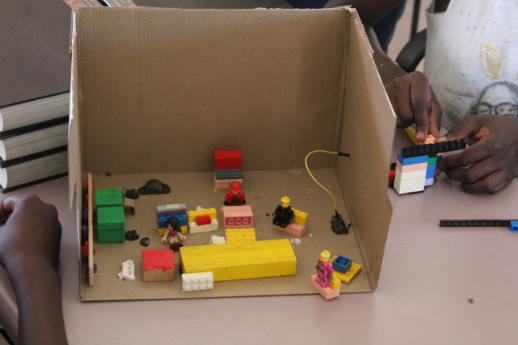 To ensure that the development of the technology is based on well-established educational theories and constructs, as well as best practices, informative data was collected. Students and teachers participated in focus group discussions and role-play around behavioral, emotional, and agentic engagement. In support of the development of an engaged classroom environment using 3D technology, the group of students was instructed to construct different environments (village and classroom) inside a cardboard box. The highly interactive cardboard construction task allowed the students to collaborate to create environments composed of various objects such as clay and LEGOs. Afterward, the team requested both the teachers and learners to imagine how teacher-and-learner interconnections that are supportive of engagement, can take place and work with 3D live streaming. By moving the objects in the cardboard box with the provision of different scenarios such as if the two individuals were separate (geographically), participants acted out and illustrated how they would solve it.
To ensure that the development of the technology is based on well-established educational theories and constructs, as well as best practices, informative data was collected. Students and teachers participated in focus group discussions and role-play around behavioral, emotional, and agentic engagement. In support of the development of an engaged classroom environment using 3D technology, the group of students was instructed to construct different environments (village and classroom) inside a cardboard box. The highly interactive cardboard construction task allowed the students to collaborate to create environments composed of various objects such as clay and LEGOs. Afterward, the team requested both the teachers and learners to imagine how teacher-and-learner interconnections that are supportive of engagement, can take place and work with 3D live streaming. By moving the objects in the cardboard box with the provision of different scenarios such as if the two individuals were separate (geographically), participants acted out and illustrated how they would solve it.
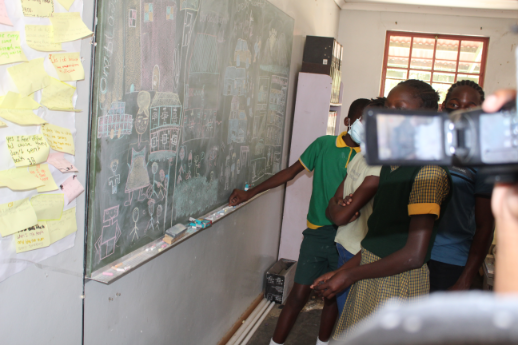
On the third day of the project, the students under the supervision of Professor Erkki Sutinen and Lani participated in a wildcard activity whereby they showcased their creativity. During this activity, the students made drawings that illustrated how they can use the HoloLens Technology to engage in their classrooms. The drawings depicted the same environments and objects constructed in the cardboard boxes. You could hear the chit-chat amongst the students as they fill the room with beautiful scenery of their marvellous drawings and the team observed them as they collaborate to put together their desired environments on a poster.
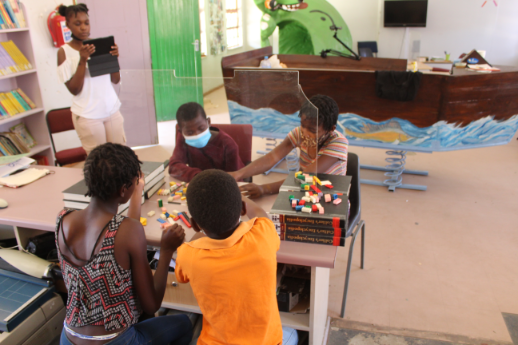
On top of that, students worked in pairs to design and construct a bridge using LEGOs. For the first session, the learners sat on opposite sides of the table with a Plexi-glass in between them, both the students had to construct one bridge and operate well together as a pair, in the next session two individuals were made to seat on each side of the table and expand the construction. The team observed the students as they explored their ideas on how to merge their worlds and determine which background and where to move each object. Ultimately, when they finished constructing their bridge the students are asked to imagine how student-student interactions can take place while being in different geographical locations.
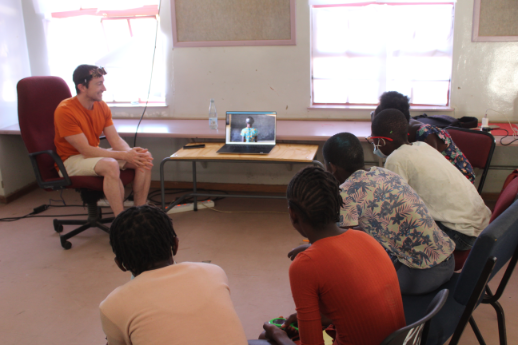 In the last session, Dr. Pope sat down in the hot seat for the “wishes for the future game” with both the students and teachers, consecutively. The game shone a spotlight on all the participants by letting to scramble down what improvements and advancements hoped to see in the 3D live streaming technology and for the technology support to engage students on sticky notes. During the game, both teachers and learners were asked questions about how to better the 3D technology by which they would write down their answers, read them out loud, and hand them to Dr. Pope, who would paste them on a poster. The position on the poster, where he decided to paste the note indicated if he is going to work on the suggestions present time, forthcoming or the suggestion is impossible to work on. While the teachers and learners proposed some ethereal ideas, Dr. Pope pasted most of them at the present. The suggestions will be incorporated into the 3D live streaming technology and introduced to students and learners in the upcoming workshop.
In the last session, Dr. Pope sat down in the hot seat for the “wishes for the future game” with both the students and teachers, consecutively. The game shone a spotlight on all the participants by letting to scramble down what improvements and advancements hoped to see in the 3D live streaming technology and for the technology support to engage students on sticky notes. During the game, both teachers and learners were asked questions about how to better the 3D technology by which they would write down their answers, read them out loud, and hand them to Dr. Pope, who would paste them on a poster. The position on the poster, where he decided to paste the note indicated if he is going to work on the suggestions present time, forthcoming or the suggestion is impossible to work on. While the teachers and learners proposed some ethereal ideas, Dr. Pope pasted most of them at the present. The suggestions will be incorporated into the 3D live streaming technology and introduced to students and learners in the upcoming workshop.
To conclude the workshop, the team made sure that both students and the teachers walked away with something to remember our visit and to show appreciation for their participation in the workshop.
